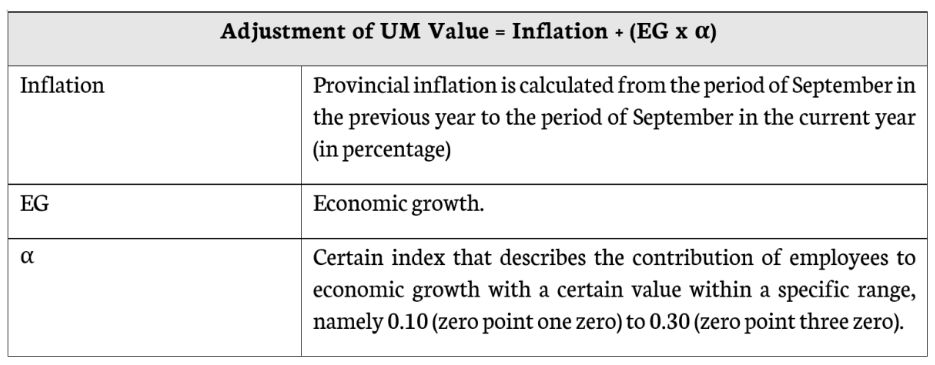- with readers working within the Banking & Credit industries
The Minister of Manpower (the "MoM") enacted Regulation No. 18 of 2022 dated November 17, 2022 on Minimum Wages Stipulation for 2023 ("Regulation 18") to allow the minimum wages in 2023 to rise up to 10% (ten percent). Provincial governments must decide on next year's minimum wage's increase rates by no later than November 28, 2022, while the deadline to decide the minimum wages at the regency/city levels will be on December 7, 2022. The increase in the Provincial Minimum Wages (in Indonesian in short known as the "UMP") and Regency/City Minimum Wages (in Indonesian in short known as "UMK") will take effect on January 1, 2023.
Prior to the enactment of Regulation 18, minimum wages are regulated only under Government Regulation No. 36 of 2021 on Wages ("GR 36/2021"). The adjustments to the 2023 minimum wages under Regulation 18 are stipulated by a new formula that combines inflation, economic growth and certain indices.
The key provisions of Regulation 18 are as follows:
New Formula for Calculating Minimum Wages
The stipulation of the minimum wages for regions that already have a minimum wage is implemented by adjusting the amount of the minimum wage ("UM"). Adjustments to the value of the minimum wage for 2023 are calculated using the formula that considers the variables of economic growth, inflation and certain indices, as follows:

The following formula calculates the adjustment of the UM amount referred to in the above formula:

Economic growth at the province level is calculated from changes in provincial economic growth in the first quarter, second quarter, third quarter of the current year, and fourth quarter of the previous year against the provincial economic growth in the first quarter, second quarter, third quarter of the previous year, and fourth quarter in the 2 (two) years before.
As for the regency/city levels, the economic growth is calculated from changes in the regency/city's economic growth in the first quarter, second quarter, third quarter and fourth quarter of the previous year against the economic growth of the regency/city's economic growth in the first quarter, second quarter, third quarter and fourth quarter in the 2 (two) years before.
The value of α must consider the productivity and expansion of employment opportunities. Furthermore, the data used for calculating the minimum wages must be sourced from a competent authority in the field of statistics and the stipulation of adjustment to the amount of the minimum wage increase must not exceed 10% (ten percent).
Minimum Wages for Regencies/Cities That Do Not Have Minimum Wages
The stipulation of minimum wages for regencies/cities that do not have minimum wages required to comply with specific requirements is as follows:
- The average economic growth of the relevant regency/city for the last 3 (three) years from available data for the same period is higher than the average provincial economic growth; or
- The value of economic growth minus the inflation of the relevant regency/city for the last 3 (three) years from the available data for the same period is always positive and is higher than the provincial economic growth.
In the event that either of the above requirements is not fulfilled, a Governor may not set a minimum wage for the concerned regency/city.
The calculation of the minimum wages for regencies/cities that do not have minimum wages is conducted in the following stages:
- Calculating the relative amount of the regency/city minimum wage against the provincial minimum wage based on the ratio of purchasing power parity.
- Calculating the relative amount of the regency/city minimum wage against the provincial minimum wage based on the ratio of employment rate.
- Calculating the relative amount of the regency/city minimum wage against the provincial minimum wage based on the median wage ratio.
- Calculating the average relative value of regency/city minimum wage as referred to in stage 1, stage 2 and stage 3 above.
It is also important to note that the variable of the purchasing power parity, employment rate and median wage are each calculated based on the average value of the last 3 (three) years of available data for the same period.
Minimum Wages for Regions Resulting from Expansion
The provincial minimum wage for provinces resulting from expansions for the first time follows the minimum wage that applies in the parent/main province. Meanwhile, the minimum wage for regencies/cities resulting from expansions for the first time follows the minimum wage that applies in the parent/main regency/city. In the case that the parent/main regency/city does not have a certain minimum wage, it follows the minimum wage that applies in the relevant province.
The calculation of the minimum wage adjustment is conducted by the Wage Council in the respective province and regency/city. Subsequently, while the calculation result of the UMP adjustment is recommended to the Governor via the Provincial Employment Agency, the calculation result of the UMK adjustment is submitted to the relevant Regent/Mayor to be recommended to the Governor via the Provincial Employment Agency.
The content of this article is intended to provide a general guide to the subject matter. Specialist advice should be sought about your specific circumstances.


